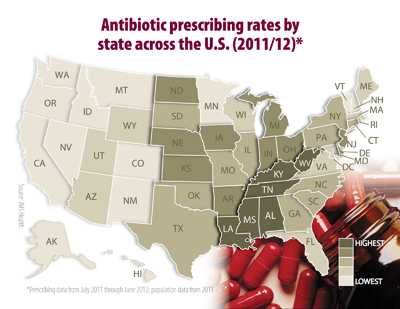This page is a historical archive and is no longer maintained.
For current information, please visit http://www.cdc.gov/media/
Press Release
For Immediate Release: Thursday, November 14, 2013
Contact:
Media Relations
(404) 639-3286
New guidance limits antibiotics for common infections in children
Get Smart About Antibiotics Week 2013 calls for responsible antibiotic prescribing
Every year as many as 10 million U.S. children risk side effects from antibiotic prescriptions that are unlikely to help their upper respiratory conditions. Many of these infections are caused by viruses, which are not helped by antibiotics.
This overuse of antibiotics, a significant factor fueling antibiotic resistance, is the focus of a new report Principles of Judicious Antibiotic Prescribing for Bacterial Upper Respiratory Tract Infections in Pediatrics by the American Academy of Pediatrics (AAP) in collaboration with the Centers for Disease Control and Prevention (CDC).
Released today during Get Smart About Antibiotics Week, the report amplifies recent AAP guidance and promotes responsible antibiotic prescribing for three common upper respiratory tract infections in children: ear infections, sinus infections, and sore throats.
Antibiotic resistance occurs when bacteria evolve and are able to outsmart antibiotics, making even common infections difficult to treat. According to a landmark CDC report from September 2013, each year more than two million Americans get infections that are resistant to antibiotics and 23,000 die as a result.
For Clinicians:
3 Principles of Responsible Antibiotic Use
- Determine the likelihood of a bacterial infection: Antibiotics should not be used for viral diagnoses when a concurrent bacterial infection has been reasonably excluded.
- Weigh benefits versus harms of antibiotics: Symptom reduction and prevention of complications and secondary cases should be weighed against the risk for side effects and resistance, as well as cost.
- Implement accurate prescribing strategies: Select an appropriate antibiotic at the appropriate dose for the shortest duration required.
“Our medicine cabinet is nearly empty of antibiotics to treat some infections,” said CDC Director Tom Frieden, M.D., M.P.H. “If doctors prescribe antibiotics carefully and patients take them as prescribed we can preserve these lifesaving drugs and avoid entering a post-antibiotic era.”
By providing detailed clinical criteria to help physicians distinguish between viral and bacterial upper respiratory tract infections, the recommendations provide guidance for physicians that will improve care for children. At the same time, it will help limit antibiotic prescriptions, giving bacteria fewer chances to become resistant and lowering children’s risk of side effects.
“Many people have the misconception that since antibiotics are commonly used that they are harmless,” says Dr. Lauri Hicks, a coauthor of the report and medical director of CDC’s Get Smart: Know When Antibiotics Work program. “Taking antibiotics when you have a virus can do more harm than good.”
These harms can be in the form of antibiotic side effects or promoting the development of antibiotic-resistant bacteria, which can then spread through a community.
CDC promotes responsible antibiotic use to consumers and health care providers through the combined efforts of the Get Smart: Know When Antibiotics Work and Get Smart for Healthcare programs, as well as during Get Smart About Antibiotics Week (Nov. 18–24, 2013) each year. State health departments, non-profit partners, and for-profit partners all contribute to the observance week’s success by spreading the word about when antibiotics work — and when they don’t.
This year’s activities include a Public Health Grand Rounds about the growing problem of antibiotic resistance in outpatient and inpatient settings on Tuesday, November 19 at 1 pm (EST). In addition, a Twitter chat on the topic will be held Friday, November 22 at 1 pm (EST). Follow the hashtag #CDCchat on Twitter and join in the conversation to talk with Dr. Frieden, CDC experts and other partners about your experiences with antibiotic resistance.
The 2013 observance of Get Smart About Antibiotics Week is an international collaboration that coincides with European Antibiotic Awareness Day, Australia's Antibiotic Awareness Week, and Canada's Antibiotic Awareness Week.
Get email updates
To receive email updates about this site, enter your email address:
Contact Us:
- Centers for Disease Control and Prevention
1600 Clifton Rd
Atlanta, GA 30333 - 800-CDC-INFO
(800-232-4636)
TTY: (888) 232-6348 - Contact CDC-INFO
 ShareCompartir
ShareCompartir




